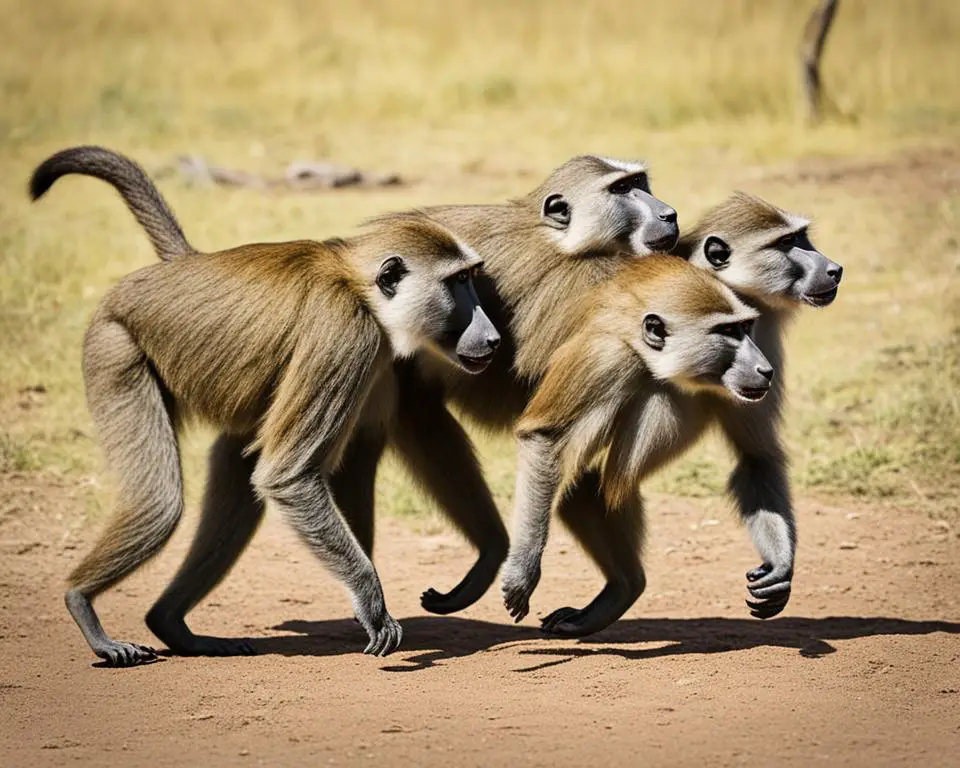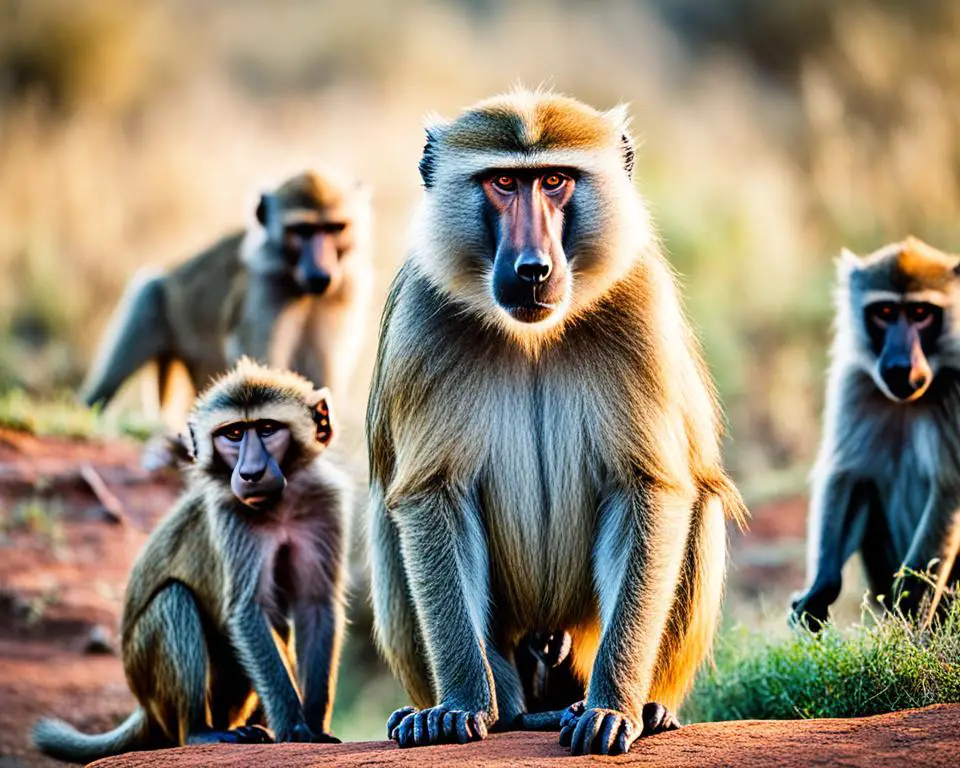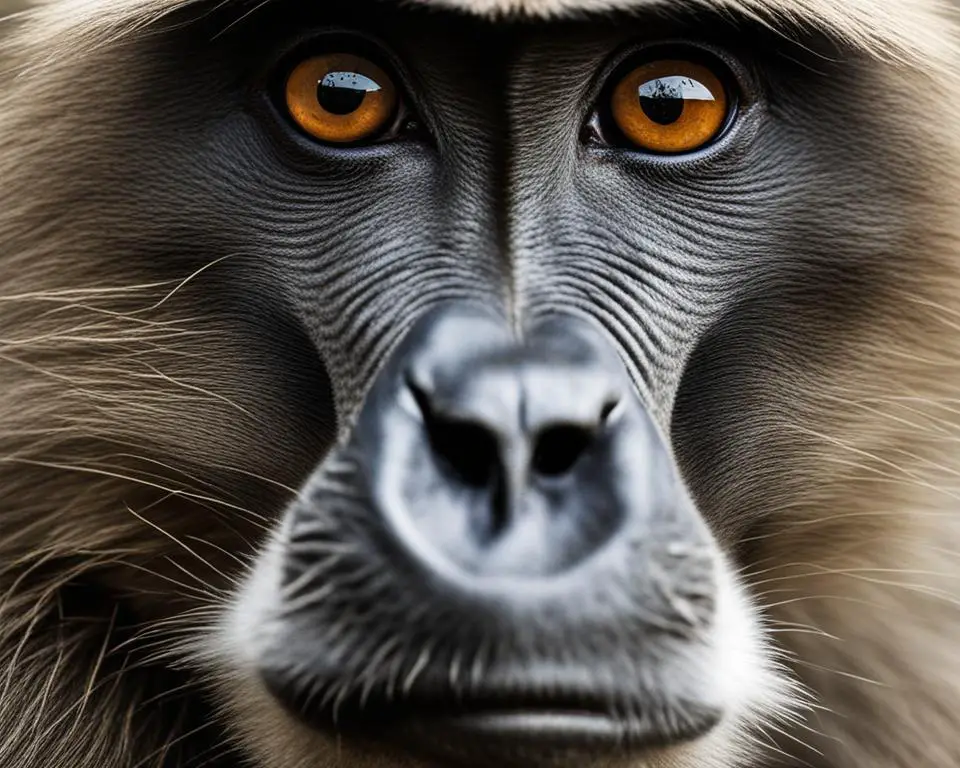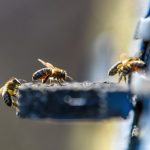When you delve into the fascinating monkey world, baboons stand out with their unique baboon characteristics—something that instantly captures your attention. These old-world primates are not just any ordinary primate species; they’re equipped with distinct tufts of hair, remarkably expressive faces, and those signature large, hairless bottoms that sometimes flash a striking shade of red. Their distinctive looks are just the beginning of a myriad of fascinating baboon facts that make these animals a topic of avid discussion and interest among wildlife enthusiasts.
Have you ever wondered how baboons fit into the larger primate picture or what sets them apart from their tree-dwelling relatives? Stay tuned as we explore more about these intriguing creatures—their sizes, habits, and the role they play in the ecosystems they inhabit. It’s time to get up close and personal with one of nature’s most compelling animals!
Discovering the World’s Largest Monkeys
As you venture into the diverse primate family, one member stands out for its sheer size and distinct physique—the baboon. Known for their unmistakable appearance, baboons are the world’s largest monkeys and boast a variety of physical attributes that set them apart from their arboreal cousins. Let’s take a closer look at the baboon physical characteristics and see how they compare in primate sizes.
The Unmistakable Appearance of Baboons
Baboons are immediately recognized by their robust bodies, dog-like muzzles, and striking facial features. Their rugged appearance includes tufts of hair flanking their faces and large, hairless bottoms, which are particularly pronounced in females during the mating season. Unlike many monkeys with prehensile tails, a baboon’s tail is non-prehensile, adding to their unique baboon appearance and terrestrial lifestyle.
Sizing Up Baboons Against Other Primates
In comparison to other primates, baboons are indeed massive. Adult baboons can grow from 20 to 34 inches in height, not including their long tails which can add another 16 to 23 inches to their length. Weighing in at around 33 to 82 pounds, they rival the mass of a human child. This impressive size underscores their status as not just the largest monkey species, but also as formidable animals within their habitats.
| Primate | Height (Inches) | Weight (Pounds) | Distinctive Trait |
|---|---|---|---|
| Baboon | 20 – 34 | 33 – 82 | Non-prehensile tail |
| Capuchin Monkey | 12 – 22 | 3 – 9 | Prehensile tail |
| Spider Monkey | 16 – 24 | 13 – 19 | Long limbs and tail |
| Chimpanzee | 30 – 37 | 88 – 130 | Tailless, more similar to apes |
As you can see, baboons not only top the charts when it comes to primate sizes, but their baboon appearance – a mix of might and distinctiveness – also underscores their evolutionary adaptations to life both on the ground and in the trees. Armed with these insights, you’re now well-equipped to identify these fascinating creatures and appreciate their place in the world of primates.
A Map of Where Baboons Roam
Have you ever wondered where you might encounter baboons in their natural habitat? The geographical distribution of baboons is as fascinating as the animals themselves. Despite being found exclusively within two continents, these adaptable primates have made various landscapes their homes. Come with us on a journey to the heart of baboon habitats.
Savannas: The Sprawling Home of Most Baboons
Imagine sweeping African savannas, dotted with acacia trees and teeming with wildlife. This is where you’ll predominantly find baboon troops. The vast open landscapes of the savannas provide these primates with rich sources of food and the space they need to thrive. These areas are crucial to the animal distribution of many baboon species and are where their social complexities beautifully unfold.
Tropical Forests and Hills: Diverse Baboon Habitats
While savannas are perhaps the most well-known of baboon habitats, these versatile animals are also at home in several other environments. Some baboon species adapt to life in tropical forests, exhibiting their uncanny ability to thrive in dense foliage where their diet diversifies to include more fruit and invertebrates. In addition, the Arabian baboons, particularly the Hamadryas baboon, reside in the distinct, rocky hills along the Red Sea coast, demonstrating these primates’ remarkable habitat adaptability.
| Habitats | Features | Baboon Species | Geographical Location |
|---|---|---|---|
| African Savannas | Open landscapes with scattered trees | Chacma, Olive, Yellow, Guinea | Sub-Saharan Africa |
| Tropical Forests | Dense foliage with varied food sources | Some populations of Olive and Yellow baboons | Central and West Africa |
| Hilly Terrains | Rugged, rocky areas near the sea | Hamadryas Baboon | Red Sea coast in Northeast Africa and Arabian Peninsula |
Understanding where baboons live can give us insight into their complex lives and the diverse ecosystems they are part of. Whether patrolling the plains of the savanna or nestled in the hills along the Red Sea, baboons are an integral part of the tapestry that makes up our planet’s wildlife.
The Ground-Dwelling Nature of Baboon Troops
As you observe the daily hustle and bustle of the African landscape, you’ll notice the prominent presence of one of nature’s most intriguing social animals: baboons. Unlike many of their primate relatives, baboons primarily exist as terrestrial monkeys, with their behaviors tailored to life on the ground. This adaptation to a ground-dwelling existence has significant implications for their social structure and the way they interact with their environment.
Understanding baboon behavior requires a glimpse into the lives of these fascinating creatures. A baboon’s day is chock-full of terrestrial activities, even though trees serve as temporary refuges for rest or to escape predators. When you see troop activities involving foraging, grooming, or playing, you’re actually witnessing the heart of baboon social life unfold on terra firma.
Baboons coexist in troops that can sometimes consist of hundreds of individuals. These large, multifaceted groups showcase the complex social dynamics of these primates, as they take part in daily activities that strengthen social bonds and ensure group survival.
- Grooming Sessions: Integral to social cohesion, baboons spend considerable parts of their day grooming each other to maintain social ties within the troop.
- Foraging Forays: Their omnivorous diet leads them across plains in search of a diverse menu—from fruits and insects to small vertebrates. These outings are as much about nutrition as they are about maintaining the troop’s hierarchy.
- Protective Patrols: Exploiting the safety-in-numbers strategy, baboons move together in formations that minimize threats from predators.
- Playful Interludes: Young members of the troop often engage in play, which is not just leisure but a means to learn essential survival skills.
At the day’s end, trees become temporary abodes where they can safely retire for a night’s rest. However, the ground remains their stage where the drama of daily life plays out.
Consider for a moment how terrestrial monkeys like baboons contribute to our understanding of primate adaptation and evolution. While observing these animals, one gains a sense of the profound connection between habitat, behavior, and the physical traits that facilitate survival in a variety of ecosystems.
Whether watching over their young, squaring off in dominance displays, or simply lounging under the African sun, baboons are quintessentially social animals, with behaviors that have been shaped by the open expanses of land they call home. Their terrestrial lifestyle is not only a crucial aspect of their survival but also a fascinating window into the lives of one of the animal kingdom’s most successful social animals.
Baboon Social Dynamics: Troops, Ranking, and Play
The intricate social structures of baboons are a marvel to behold. Imagine looking out onto the savanna and observing a troop in action; it’s akin to monitoring a bustling village where each member has a role, and a status woven into the fabric of the collective. The group dynamics within baboon troops are a testament to the complexity found in natural societies, strikingly reminiscent of human social patterns.
Let’s delve into the world of these charismatic primates to understand how their social structures support their survival and success within diverse African landscapes.

- The Hierarchy of Baboon Troops: Dominance could not be more crucial than it is in a troop. Males achieve their standing by means of age and size, fostering a natural ranking system that establishes order and reduces conflict within these large primate groups.
- The Matriarchal Lineage: For females, rank is often a birthright. With statuses determined by the lineage, baboon females display social ladder dynamics different from their male counterparts, advocating for their progeny and shaping the troop’s generational continuity.
- What Grooming Reveals: Much more than a cleanliness routine, grooming among baboons is a deliberate social endeavor, solidifying bonds and reinforcing the oaths of allegiance in accordance with the ranking system.
- Mutual Protection: In the face of danger, baboons stand united. Their collective dynamic during risky scenarios exemplifies the level of cooperation and mutual respect prevalent in their group dynamics.
Amidst the seriousness of survival, playfulness has a shining role, particularly among the young. You might witness wrestling matches, playful chases, and acrobatics akin to the child’s play seen in human communities, signifying the importance of play in social and cognitive development.
Within these troops, every baboon from the lowest to the highest ranking has a role that maintains the equilibrium of their society. It’s a system that reflects not just the intellect of these primates but also their evolutionary success in forming enduring social bonds. Observing these troops is observing a mirror to our own societal underpinnings, where each being, regardless of stature, contributes to the collective whole.
| Behavior | Purpose | Impact on Troop |
|---|---|---|
| Grooming | Social bonding | Strengthens relationships and establishes trust |
| Play | Learning and skill development | Prepares the young for adult roles within the troop |
| Foraging together | Food acquisition | Ensures the survival and health of the troop |
| Establishing hierarchy | Reduction of conflict | Maintains social order and structure |
As these baboon troops navigate the savannas of Africa, their collective experiences, from nurturing their young to foraging for food, create a rich tapestry of life that underscores the resilience and adaptability of their kind. It’s through understanding these dynamics that we gain a broader insight into not just baboons but the nature of all social animals.
What’s on the Menu? The Omnivorous Baboon Diet
Peek into the eclectic world of baboons, and you’ll find a diet as diverse as the ecosystems they inhabit. These omnivorous primates aren’t fussy about their food, and their ability to consume a variety of sustenance is truly remarkable. Let’s explore the cornucopia that makes up the baboon diet and examine how this affects their natural habitats and human agriculture.
The Varied Cuisine of Baboons
If there’s one thing that’s certain about baboons, it’s their flexible palate. With an appetite for almost anything edible, these non-specialized foragers take the term ‘omnivore’ to the next level. Their meals can range from the tender grasses of African savannas to the succulent fruits dangling from the trees, weaving the very fabric of their existence into the vast tapestry of nature’s bounty.
Baboons are adept at hunting for animal prey, including rodents, birds, and even the young of certain ungulates. Their broad diet also sweeps across the insect world, where they slurp up nutritious grubs and other diminutive critters. Seeds and roots are no strangers to a baboon’s menu, giving these primates a pivotal role as both predators and seed-dispersers in their ecological niches.
Your typical baboon’s diet isn’t limited to what nature offers freely. They are opportunistic enough to engage in natural foraging behaviors that take advantage of seasonal abundance. From water-laden roots after the rains to the bursting flavors of summer fruits, these primates’ dietary habits are a testament to their adaptability and survival skills.
The Impact of Baboons on Local Agriculture
However, not all of the baboon’s feeding habits are met with admiration. As agricultural pest controllers can attest, baboons are known to give farmers a hard time. Due to their omnivorous nature, troops often venture into farmlands, lured by the easy pickings of crops and causing significant agricultural damage. While these primates see a field of maize as an open invitation for a feast, farmers view these raids as a dire threat to their livelihood.
Efforts to mitigate the conflict between baboons and farmers include various deterrence methods, but the essence of the problem lies deeper. The expansion of human settlement into natural habitats has pushed these intelligent primates into a corner, compelling them to adapt in ways that sometimes collide with human interests. As agricultural pests, they challenge us to find balanced solutions that respect the wildlife whilst protecting the fruits of human labor.
The baboon diet stands as a clear indicator of the complex relationship between wildlife and human activities. While we grapple with the issue of baboons as agricultural pests, their natural foraging behaviors continue to shape the ecosystems they inhabit—a reminder of the intricate connection between all living creatures and their environments.
Mating Signals and Offspring Care
As you venture into understanding baboon reproduction, you’ll find fascinating behaviors, particularly in female baboons. The visual cues and nurturing practices are essential for the continuity of their species. Observing these signals and care strategies provides an inside look at the complex world of primate parenting.
The Role of Female Baboons in Reproduction
Female baboons showcase clear mating signals to indicate their readiness for reproduction. During the mating season, their bottoms swell and redden, sometimes expanding by up to 6.5 inches, creating a visual advertisement of fertility to attract potential mates. This physiological change is a definitive sign within the baboon social structure, signaling that the female is prepared to mate.
Gestation in baboons lasts approximately six months, culminating generally in the birth of a single infant, although rare instances of twins have been recorded. The rate of baboon reproduction, combined with the care they provide their young, ensures the survival of the species even in the dynamic landscapes they inhabit.
Growth Stages of Baboon Offspring from Infancy to Adulthood
After birth, infant baboons immediately begin their life journey, weighing around 2 pounds. In a remarkable display of maternal instinct, infants cling tightly to their mother’s fur, relying entirely on her for transportation and nourishment. Nursing lasts until weaning starts at around 3 to 4 months, a critical period filled with learning and growth.
The development of baboons continues steadily from infancy to the juvenile growth stage. Prior to reaching maturity, juvenile baboons experience rapid growth and social learning, growing one pound every three months. This phase is vital for learning the intricacies of troop interaction, developing foraging skills, and understanding social hierarchies.
As baboons transition into adulthood, social dynamics shift, particularly for males. Males often leave their natal groups to join other troops, a behavior that fosters genetic diversity and strengthens social bonds across troops. Females, on the other hand, typically remain within their birth groups, nurturing the next generation and maintaining the core structure of the troop.
The juvenile growth curve mimics a child’s journey to becoming a fully capable adult within a human community. Like us, each stage of growth brings new challenges and learning opportunities that hone the survival skills necessary for life in the diverse habitats they occupy.
| Age Stage | Weight at Birth | Weaning Age | Weight at Juvenile (2 years) |
|---|---|---|---|
| Infancy | ~2 pounds | 3-4 months | Not Applicable |
| Juvenile | N/A | Completed | +1 pound every 3 months |
| Adulthood | N/A | Completed | Varies by sex |
The life of baboons, from the clear mating signals of the female to the gradual development of infant baboons into social adults, is a narrative interwoven with care, growth, and community. Understanding these stages not only enriches our knowledge but also fosters a deeper appreciation for these extraordinary primates.
Understanding Baboon Taxonomy
As we delve into the fascinating world of primates, the Baboon taxonomy reveals a rich tapestry of diversity within this primate genus. Deciphering the species classification offers insights into their evolutionary history and how they relate to other members of the animal kingdom. Let’s explore the classification of these remarkable creatures and understand their place in the Papionini tribe.
The Classification of Baboon Species
Delving into the specifics, baboons belong to the genus Papio, which comprises several species that exhibit varied adaptations to their respective habitats. Recognized for their distinctive traits and behaviors, baboon species classification can be fascinating.
- Papio anubis – the olive baboon, known for its widespread population across Africa.
- Papio cynocephalus – the yellow baboon, which has a dog-like appearance and inhabits open savannas and woodlands.
- Papio hamadryas – the Hamadryas baboon, distinguished by its fluffy mane, usually found in the Horn of Africa and southwestern Arabia.
- Papio kindae – the Kinda baboon, recognized by its more slender build and lighter coloration.
- Papio papio – the Guinea baboon, with its smaller size and bright red rump, found in West Africa.
- Papio ursinus – the chacma baboon, known for its significant size, mostly seen in southern Africa.
Although commonly categorized with baboons, the Gelada baboon is distinct in its own right, belonging to a different genus – Theropithecus gelada. Residing in the highlands of Ethiopia, the Gelada is a unique member of the Papionini tribe, demonstrating the diversity and complexity of primate lineage.
The variety seen within the Papio genus highlights the evolutionary adaptability of these species. Their widespread distribution across Africa and into parts of the Arabian Peninsula underscores the successful nature of this primate genus. By understanding the species classification of baboons, you gain a clearer picture of their ecological significance and the conservation challenges they face in the wild.
Conservation Efforts and Predation Challenges
As guardians of Earth’s rich biodiversity, understanding and participating in baboon conservation efforts is crucial. While baboons face various predation threats that are natural to their environment, the advent of human-wildlife conflict has introduced new layers of complexity. Let’s explore the dual challenges of natural predators and human impacts, and how they inform our conservation strategies and wildlife protection efforts.
Human Impacts on Baboon Populations
Our ever-expanding footprint on the natural world has not gone unnoticed by the baboon populations inhabiting the African continent. The intermixing of human settlements with baboon habitats leads to inevitable human-wildlife conflict, adding strain to the delicate balance of ecosystems. Intensive farming practices infringe upon traditional baboon territories, resulting in habitat loss and placing the Guinea baboon on the Near Threatened list of the International Union for Conservation of Nature and Natural Resource’s Red List.
Furthermore, baboons’ adaptable nature sometimes backfires, as their foraging can lead to them being labeled as pests, thereby triggering lethal control methods. Educating communities on humane conflict resolution techniques and promoting policies that factor in habitat corridors are integral to fostering coexistence.
Natural Predators of Baboons and Their Defenses
The law of the wild dictates eat or be eaten, and baboons are no strangers to this reality. Our primate cousins face the relentless threats of predation from apex predators like cheetahs and leopards. These encounters test the defense tactics of baboons, which include a repertoire of vocalizations and baring of teeth to dissuade would-be attackers.
Effective predator-deterrent strategies amongst baboons involve vigilance and cooperation within the troop. Alarmed barks can signal the presence of a threat, rallying the troop to a defensive position. Baboon troops may also strategically sleep in trees at night to minimize nocturnal predation risks. While  predation represents a natural ecological pressure, it’s important to respect the role of predation in shaping healthy populations and ecosystems.
predation represents a natural ecological pressure, it’s important to respect the role of predation in shaping healthy populations and ecosystems.
All of this underlines the need for a comprehensive approach to baboon conservation. We must commit to protecting these animals not only for their intrinsic value but also for the crucial role they play in maintaining the ecological fabric of their native landscapes.
| Conservation Concern | Impact on Baboons | Current Initiatives |
|---|---|---|
| Habitat Loss | Decrease in native living areas, leading to population pressure | Creation of protected areas and habitat restoration |
| Human-Wildlife Conflict | Risk of lethal management, negative public perception | Community education and conflict-mitigation strategies |
| Predation | Natural population control, occasional loss of individuals | Conservation of predators and balanced ecosystems |
Baboons in Human Culture and Communication
Within the intricate tapestry of human-primate relations, the communique exchanged between baboons delivers a fascinating perspective on both their societal interactions and the genetic resemblance they share with us. Grasping the depths of baboon communication not only piques our curiosity but also enhances our broader understanding of primate behavior and evolution.
The Vocalizations of Baboons
With a symphony of sounds that permeate the African landscapes, baboons utilize a rich palette of vocalizations to connect with one another. These vocalizations, a subject of diligent vocalization studies, comprise a minimum of 10 distinct variants, encompassing an array of calls and barks that serve as alarms, mating calls, and social binding threads within their communities. This intricate sound-based language system underscores the exceptional nature of baboon communication, which remains a cornerstone in deciphering the subtleties of primate exchange.
In-depth research into their vocal patterns reveals not just basic alerts or mating cues, but a nuanced dialogue well-suited for their complex social hierarchies. Observers and researchers alike are continually intrigued by the potential parallels between baboon vocalizations and the developmental precursors of human speech, elevating the scope of these studies beyond mere curiosity.
Genetic Similarity Between Humans and Baboons
The genetic tapestry that links humans and baboons is threaded with similarities, including a remarkable 94 percent shared DNA, which opens doors to understanding fundamental aspects of our own nature. This genetic resemblance bridges the divide between the species, providing valuable insights into the evolutionary lineage that we share with these primates. Gelada baboons, in particular, exhibit a diverse array of yawns, employed as communicative gestures, perhaps echoing the emotive expressions found in humans.
As continued dialogue in the field of human-primate relation advances, the line distinguishing human and baboon behaviors becomes increasingly nuanced. The thoughtful consideration of these genetic commonalities informs not only our academic perspectives but also our empathetic stances towards these sentient beings who mirror, in many ways, reflections of ourselves.
In the grander narrative of life on Earth, the bonds we share with baboons draw a compelling correlation. It prompts a richer appreciation of the threads that weave us into the complex ecological and evolutionary fabric of our planet, urging us to pursue conservation and study with impassioned zeal.
Vocal and Physical Expressions: Understanding Baboon Language
Delve into the realm of primate communication and you will discover an intricate system of baboon signals that goes beyond mere sounds. In the social world of baboons, both visual cues and vocalizations play a crucial role in conveying messages across the troop. From warning calls to expressions of hierarchy, each baboon’s movements and sounds are pieces of a complex communicative puzzle.
Let’s peer into the details of baboon language and appreciate these profound forms of expression integral to baboon life. You’ll find that, for baboons, survival hinges not just on physical prowess but equally on their abilities to signal effectively.
Imagine you hear a series of barks exploding through the savanna; these are alarm calls – a component of the baboon’s extensive vocal language designed to alert the troop of impending danger. Meanwhile, social harmony is maintained through gentler vocalizations, manifesting the intricate layers of primate communication.
Physical assertions of dominance may include displays of vivid eyelid flashing or the intimidating exposure of canine teeth through yawning, underpinning the baboon’s reliance on visual cues. Submissive baboons may respond with tooth grinds, ear flattening, or low-toned grunts, their body language diffusing tension and acknowledging their place within the social hierarchy.
Here, we piece together a picture of these expressions, outlining the range of vocal and physical signals used by baboons:
| Expression | Type | Meaning | Note |
|---|---|---|---|
| Alarm barks | Vocalization | Warning of danger | Used to alert the troop |
| Yawning | Physical | Dominance display | Shows large canines |
| Eyelid flashing | Physical | Aggression or irritation | Sometimes accompanied by screams |
| Tooth grinding | Physical | Submission or stress | A quiet signal between individuals |
| Ear flattening | Physical | Submission or fear | Often seen in young or low-ranking baboons |
Given their potential for confrontation, effective communication is vital in preempting conflict and ensuring group cohesion. A troop’s ability to coexist and coordinate hinges on the nuanced art of articulating through both visual cues and vocalizations, reflections of their heightened social intellect and the keys to their evolutionary success.
As you witness these dynamic forms of baboon signals unfold, you gain insight into the sophisticated means by which these primates manage their complex social networks. They demonstrate the high level of intellect found across primate communication, linking them closely in capability and behavior to many higher mammals, including humans.
Traditional Behavior: Baboons Using Infants as Peace Offerings
Witnessing primate behavior in its natural habitat is already captivating, but the social intricacies of baboon interactions reveal an advanced level of intelligence that might just take your breath away. Imagine observing a male baboon cautiously approaching a rival with an infant clutched in his arms—a gesture so profound, it’s often likened to a white flag during human conflicts. This is more than a mere act of survival; it exemplifies the sophisticated use of social tactics for conflict avoidance within baboon communities.
These intelligent primates have developed a unique way to foster peace and reduce potential aggression. Males carrying infants are rarely met with hostility, and this behavior has been interpreted by primatologists as a tactical move to subdue tension and navigate the troop’s complex hierarchy safely. This strategy could even be considered a form of diplomacy in the primate world.
- Infant as a Buffer: By presenting an infant, a male may reduce the risk of retaliation from another male, creating an opportunity for safe interaction or passage through a rival’s territory.
- Tension Diffusion: The sight of an innocent infant tends to soften the demeanor of other baboons, lowering the likelihood of confrontational encounters.
- Strategic Alliance: Holding an infant can also be seen as a request for alliance or acceptance into a new troop, a crucial step for male baboons who often migrate between groups.
This fascinating aspect of baboon behavior underscores their social complexity and demonstrates a depth of intelligence that challenges our understanding of non-human societies. Remarkably, such behaviors hint at the emotional capabilities of baboons, suggesting they recognize the importance of infants within their communities, not only for the continuity of their species but also as integral members of their social fabric.
As you delve deeper into the social phenomena that characterize these primates, it becomes clear that baboons possess an intricate understanding of their social environment, employing sophisticated strategies to navigate it. Such observations have profound implications for our understanding of other animal societies and the evolutionary foundations of conflict resolution and cooperation. There’s much to learn from these intelligent creatures whose social engagements reflect a high-end approach to peace and reconciliation.
Reproductive Strategies and Attracting Mates
When observing baboon mating behaviors, one cannot help but be intrigued by the distinctive reproductive behaviors these primates exhibit. During the estrous cycle, female baboons display clear physiological signs that signal their readiness to mate. You might notice their bottoms become notably swollen and red – this is not just a colorful display, but a crucial signal in the baboon mating process, designed to attract potential mates. This period of sexual receptiveness is crucial, as it dictates the social dynamics and mating strategies within the troop.
Baboon males take mating opportunities seriously, often vigorously defending their chosen partners from rivals and potential threats. The might of a male baboon is readily apparent by their formidable canine teeth, which they use not only for foraging and defense but also as a demonstration of prowess during mate attraction. The swelling of the female’s genitalia plays a pivotal role, influencing male baboons’ receptiveness—ultimately guiding the selection process of their mating partners.
The reproductive behavior of baboons is both complex and fascinating, encompassing a range of rituals and signals aimed at ensuring successful mating and the protection of offspring. Mate attraction in baboons is a dramatic dance, with the stakes high for both sexes. As the females signal their availability and the males display their fitness and readiness to defend, the cycle of life ensures the continuity of the species through these intricate behavioral patterns.










